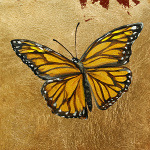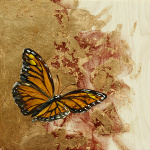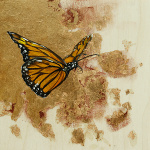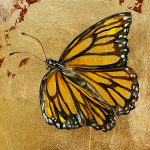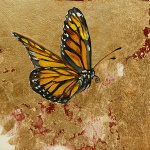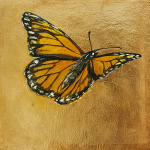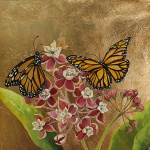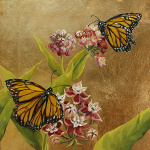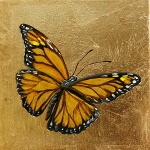Monarch Kaleidoscope
Oil and copper leaf on wood panels.
Available for exhibit, contact me to inquire (link to my email)
Price: Inquire for individual panels or complete installation (link to my email)
Did you know that a group of butterflies is called a Kaleidoscope?
With this series of paintings, I depict the beauty of the monarch butterfly and the milkweed plants that sustain them.
The annual migration of North America’s monarch butterfly is a unique and amazing phenomenon. The monarch is the only butterfly known to make a two-way migration as birds do. Unlike other butterflies that can overwinter as larvae, pupae, or even as adults in some species, monarchs cannot survive the cold winters of northern climates. Using environmental cues, the monarchs know when it is time to travel south for the winter. Monarchs use a combination of air currents and thermals to travel long distances. Some fly as far as 3,000 miles to reach their winter home.
Because all the migrating monarchs are concentrated in just a few locations during the winter, they are especially vulnerable to harsh weather and to human activities that disrupt or destroy their habitat. This can reduce the number of monarchs that leave the overwintering sites in the spring. Similarly, migrating and breeding monarch populations are vulnerable to harsh weather and to human activities that reduce milkweed and nectar sources. Milkweed is the main food source for Monarchs. They also lay their eggs on Milkweed. This important pollinator is in danger with a 90% population decline in recent years.
The Monarch Butterfly is threatened species, and in need of our help and protection. Through my artwork I hope to increase environmental awareness and conservation of our natural world.
(reference: USDA website on wildflowers/pollinators)
